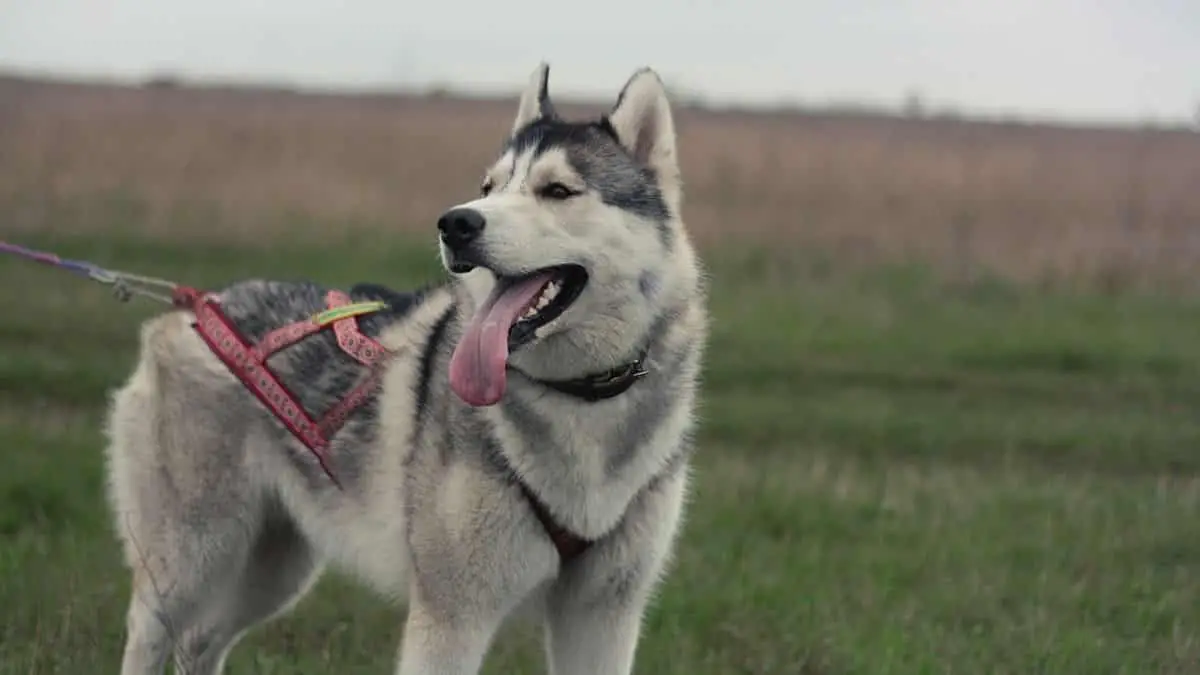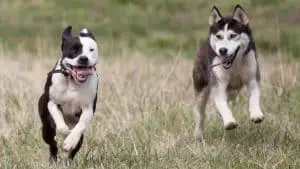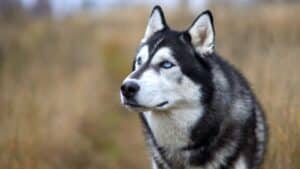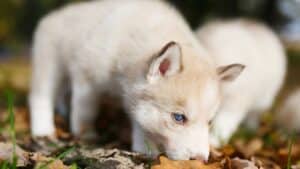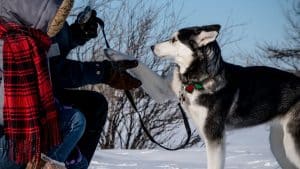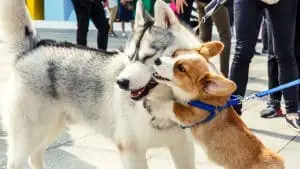Can Huskies Walk In The Rain? 6 Things You Should Know
Siberian Huskies are mainly found in high-altitude areas of the world. Some of you might ask if Huskies can walk in the rain? Owing to the thick double layer of fur, Huskies can withstand icy and harsh weather conditions.
Being athletic and of very high endurance, Huskies are generally used as sledding dogs. They help transport, carry goods and humans alike over hilly-snowy locations, where your general means of motor and transportation fails to be of any use.
Taking your Husky out for a walk on a nice rainy day is no big deal. Experts and studies agree with this statement unless it’s quite literally pouring down cats and dogs. If you aren’t planning to subject yourself and your dog to a thunderstorm, you and your Husky will be both just fine.
The problem of walking your dog in the rain lies not in the rain itself. It’s about the inherent dangers that could arise out of the many situations in the near surroundings that are produced by the rain.
From the sounds of raindrops to the wet grass is all but a new feeling for your dog. Be it a Husky or any other dog, it comes to them all the same.
Table of Contents
Be Comfortable With the Unexpected
Huskies are endowed with genes, designed to bear and thrive in conditions where other breeds of dogs might find it harder to live in. From the Husky’s feet to the tip of their ears, there are only a few places where they might be taxed by cold weather.
Hence, it is pretty safe to say that Huskies can very well be walked in the rain. Huskies are built for cold outdoor climates. They possess an undercoat. Essentially what you mean by this is that the undercoat, as mentioned earlier, protects their skin. It also helps in preventing rain or snow directly on their skin.
Huskies can stay out in the snow for hours. Some light rain will barely affect them in any way.
Walking Your Dog in the Rain The Right Way
Protection is a must
Make a note of this point. It cannot be stressed enough how important this step is. One of the significant concerns of pet parents is regarding your dog getting exposed to microorganisms. Adding to that are chemicals or any other potentially harmful substances that might latch onto your dog.
There are many dog accessories in the market to prevent such mishappening from occurring—one of those being Dog Boots. Although many dogs are uncomfortable wearing one, it indeed takes time to get used to this.
There’s also the choice to get for your dog a raincoat. But then again, Huskies, in particular, don’t really require one owing to their thick, double fur that acts as a raincoat anyway. The alternative could be a Dog Umbrella.
Your dog’s comfort is a priority
Just as not all people like walking in the rain, not all dogs love the feeling of getting their fur and paws getting wet. Although, you can make them get used to it. You can try incorporating them into the practice of walking some of the principles of treats-based, positive reinforcement-focused training. The idea and aim here are to associate walking in the rain with pleasant experiences.
Siberian Huskies are a breed that is bred to be immensely resilient to cold. They can endure temperatures as low as -60 Degrees Fahrenheit, which is around -51 Degrees Celsius. Although they thrive in freezing temperatures, care should be taken under hotter weather conditions.
Just like it is with human beings, dog behavior fluctuates with how warm or cold the living conditions are. You might be feeling a little under the weather, gloomy and sad on a cloudy day. However, on a lovely spring sunny day, you might feel more cheerful and peppy. Such is the case with dogs too.
Huskies being heavily furred dogs have a difficult time surviving in warmer climates. Hence, it is advisable for anyone living under such conditions to refrain from getting a Husky or any dog that falls under that category.
According to a study done by Orvis, pay careful heed to the following factors:
- your Husky’s fur type
- how long their snout is
- the surfaces your dog can walk on
Dog breeds like Huskies that feature a double layer of fur are quite vulnerable to humidity as well as high temperature.
Make sure to brush their coat regularly to remove the excess undercoat so that the air circulates smoothly throughout the hair. The study also exclaimed that it is not advisable to shave off their fur to tackle the warm conditions.
Huskies have a long muzzle length since they basically are sled dogs and are meant to endure very cold conditions and heavy-duty activities.
The walking surface differs from place to place and from weather to weather.
Huskies have typical slim but strong and sturdy paws. Their paws are covered with fur on the sides of the toes to keep them warm in cold climates. But if you take your Husky for a walk under the rain, do remember to wipe it off clean as soon as you reach home.
Shorten Your Walks
In case of a heavy downpour, you should cut the walks short. Instead, you can have interactional leisure time inside the house. Of course, if it’s a light shower, you can play outside with your Husky.
At the end of the day, what matters is your pet’s health and safety.
Seasonal Allergies
Huskies are prone to Zinc deficiencies. It can cause itching, hair loss, and lesions on the footpads, face, and genitals.
- Dry or greasy tissues may start appearing throughout the nose, face, snout, tail, ears, side, and stomach. Without treatment, these affected spots may get infected, and that can be very painful for your Husky.
- Food is interrelated to skin inflammation, just as it is with people. Your Husky can experience an allergic reaction from certain foods, which leads to inflammation or irritation of their skin. It’s usually caused by animal proteins such as beef or chicken and sometimes eggs, milk, or corn.
Some of the treatments are as listed:
- Provide your Husky with the one ingredient diet for the duration of eight weeks.
- Make sure you give no treat to your dogs, or even flavored medicines, or additives throughout those eight weeks.
- Once the phase is over, start providing your dog normal food again and observe.
Exercise
Huskies are very active, athletic dogs that need a lot of exercise. A busy and active Siberian is a happy and healthy Siberian.
During winters, bundle up and take your Husky for a walk. During the summers, you should only walk your Husky in the early morning or when the sun goes down.
Factors to be Considered before Adopting a Husky
- Climate: This is the first and foremost and the most crucial factor to take into account before you think of adopting a Husky. Huskies thrive under cold weather conditions, and it’s very hard and uncomfortable to survive in a warm place.
- Living Space: Huskies require a lot of space. Being very active and energetic dogs, they need a big area to use up all of their pent-up energy on a day-to-day basis.
- Noise: Let me just say there are better guard dogs out there. Instead of your husky barking at the intruder, he might just befriend them..
- Diet: You would think that it would require a lot for you to provide when it comes to the diet for your Husky. Especially if you were to adopt one into your family since they are so energetic. But in reality, they can get on by relativity little. Just make sure they get all the nutrients they need for their overall growth.
- Grooming: Since Huskies have thick fur, be ready for a fluffy explosion around winter, as huge clumps of hair quite literally blow off of your dog. A vacuum would come in handy then.
All in all, making your dog walk in the rain will actually be quite an experience for your dog. Since it’s something that doesn’t happen daily, observing how your dog behaves under such conditions would certainly help you as a pet parent.
In this way, you will get to know your dog even more. You would also learn from such experiences and also become a better parent for your dog.
Walking your dog in the rain indeed can be a cumbersome process and demands firm responsibility on your part. However, it’s all a part of the process.
It’s a time through which you and your dog can develop the bond. Not just that, you can learn to trust in one another even more than before.
It would be helpful to keep your pet’s health and safety in your mind as a priority and wearing pet-appropriate clothing. By doing so, you will be able to create the moment for you and for yourself alike. It’ll be a memory that will stay and linger with you for a long, long time.

